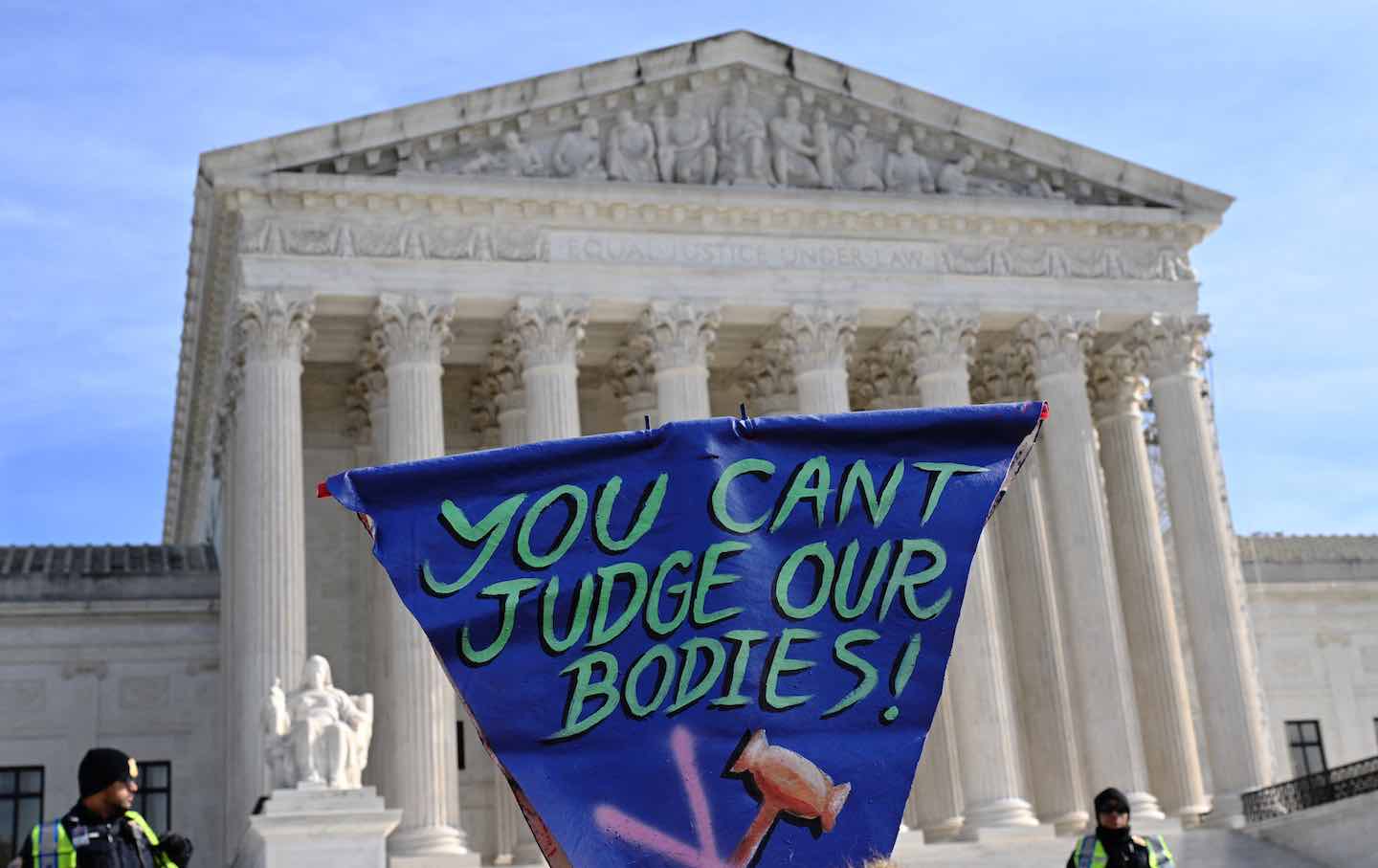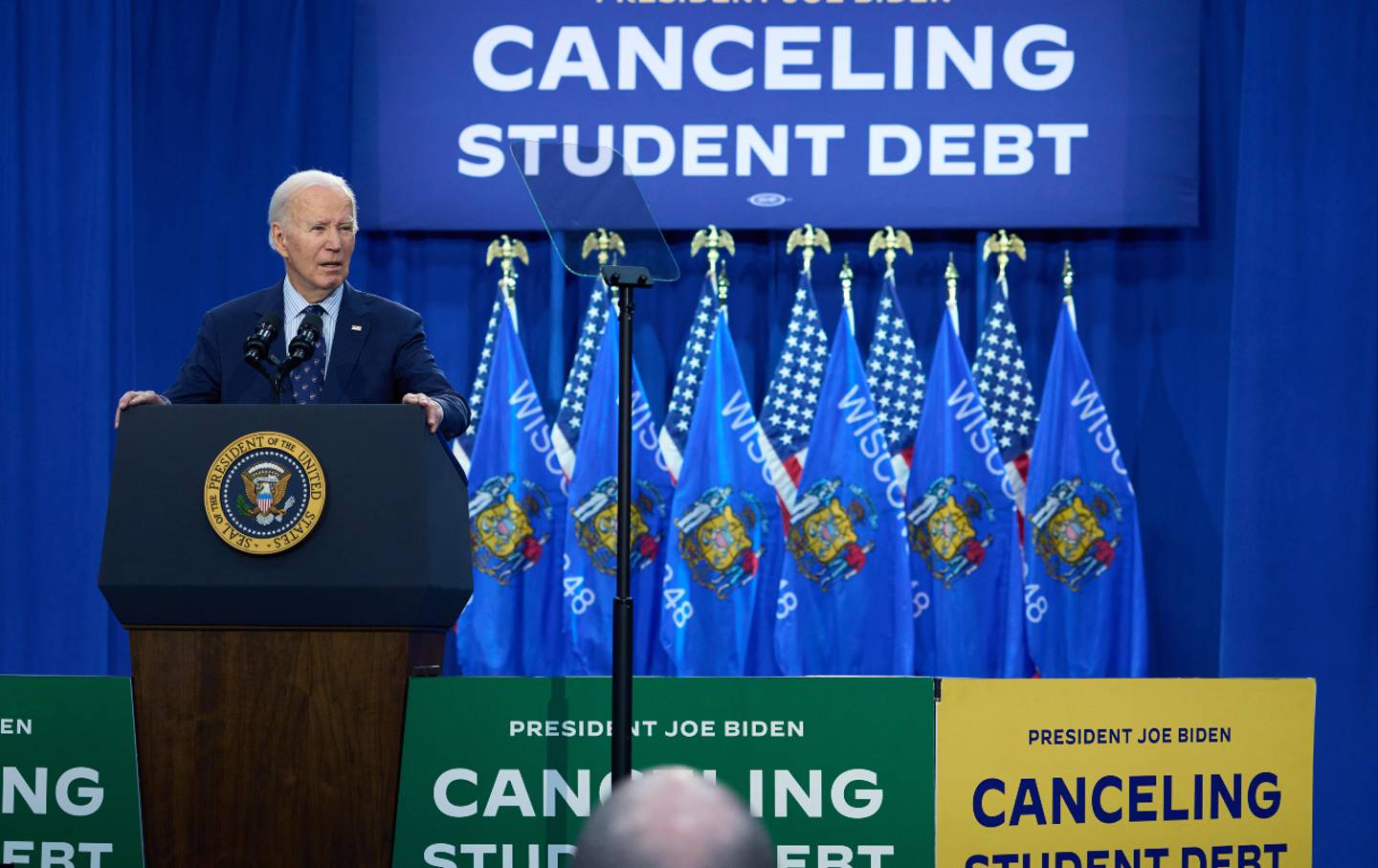The Supreme Court Wants More People to Die in Mass Shootings
This is the only possible conclusion after their decision striking down the federal ban on bump stocks.

A makeshift memorial for the victims of the Las Vegas mass shooting who were killed when a gunman opened fire on them in October 2017.
(Bilgin S. Sasmaz / Anadolu Agency / Getty Images)
We live in this most violently gun-addicted industrialized nation on Earth for one reason, and one reason alone: Republicans control our Supreme Court. The gun violence that rages throughout our country does not happen because Americans are more culturally prone to violence than other people. It doesn’t happen because we play violent video games or watch violent movies. It doesn’t happen because of racial strife, poverty and inequality, or economic grievances. It happens because the Republicans operatives on the court welcomes violence. It happens because they simply won’t allow us to protect ourselves from violence; because they would rather watch children die than risk Congress or the president laying a finger on the National Rifle Association or Ruger or any arms dealer who makes their living selling death. It happens because we allow six ammosexual maniacs sitting on the Supreme Court to rule over all of us, despite the fact that none of us voted for them.
The latest savage act of the court’s conservative death cult comes in the form of Garland v. Cargill. In a 6-3 ruling earlier today, divided along partisan lines, the conservative majority overturned a 2017 ban on “bump stocks” that was enacted by the Bureau of Alcohol, Tobacco, and Firearms (ATF) during the Trump administration. In 2017, a mass shooter killed 60 people and injured over 400 when he fired on a crowd at a Las Vegas music festival. Paddock was able to kill and injure so many people because he had turned his semiautomatic weapon into a fully automatic weapon—functionally, a machine gun—with the aid of a bump stock.
A bump stocks is a mechanical device, affixed to the butt of a gun, that captures the recoil from firing a weapon and cycles that kinetic energy back into the shooter’s trigger finger. The shooter fires a bullet, the weapon “bumps” against their shoulder, and that action produces an additional bullet, and so on. By using bump stocks, Paddock was able to fire over 1,000 bullets in 10 minutes in Las Vegas.
The Las Vegas music festival massacre is the deadliest mass shooting ever carried out by a single gunman in US history. One of the reasons it is still the deadliest mass shooting in the history of the country—despite the fact that it happened seven years ago and this country endures a mass shooting nearly every day, including 225 in 2024, so far—is likely because, after the shooting, the Trump administration banned bump stocks. “Machine guns” and enhancements that turn guns into machine guns have been banned in this country since 1934, thanks to the National Firearms Act. Trump’s ATF merely classified bump stocks as one of those attachments that makes a gun a machine gun, and took it off the market.
The move angered ammosexuals who need bump stocks for… well, I can’t tell you why anybody would need to fire 1,000 bullets in 10 minutes, other than to kill as many people as possible. Nevertheless, a gun-store owner named Michael Cargill sued the ATF for making him give up his bump stocks. Conservatives quickly glommed onto the case, including Republican neo-Confederate super-lawyer Jonathan Mitchell (who invented the Texas abortion bounty hunting law). That makes sense when you remember that Republicans like Mitchell think women should be forced to carry unwanted pregnancies to term; this way, women can give birth to additional targets for ammosexuals to aim at.
The case was argued in front of the Supreme Court in February and, as I explained at the time, the justices came up with a grammatical way to determine whether bump stocks fall under the umbrella of the National Firearms Act ban on machine guns and machine-gun enhancements, instead of a rational one; they pretended the legal issue hinged on whether bump stocks could be determined to work by means of a single “function” of the trigger or by means of a single “pull” of the trigger. Conservatives argued that bump stocks cannot be banned because they still require the trigger to “function” once per bullet. Liberals argued that bump stocks can and must be banned because the shooter “pulls” the trigger only once to fire a continuous hail of bullets.
This is an easy case if you look at it from the perspective of the shooter. With the aid of a bump stock, the shooter pulls once, and the gun fires automatically, just as it would in the case of a machine gun. But the conservative majority insisted on looking at the case from the perspective of the gun. Clarence Thomas, writing for the majority, included multiple diagrams of the inner workings of a gun, to illustrate that the gun is operating based on multiple “functions” of the trigger. His framing would make sense if guns could think for themselves, fire for themselves, and perform musical numbers encouraging school children to “be my guest” or, more likely, “make my day.” But since guns are not anthropomorphized Disney characters imbued with agency and purpose, Thomas’s decision to center the law from the perspective of the gun is both stupid and horrific.
The shooter is the one with agency in this situation. The shooter is the one who pulls the trigger. How the gun fires, from the shooter’s perspective, is the legally important question here, not the inner monologue of the clockwork.
Sonia Sotomayor called out the majority’s entirely wrong frame in her dissent. She wrote: “A machinegun does not fire itself. The important question under the statute is how a person can fire it.”
But she didn’t stop there. Underneath the majority’s inane focus on the operation of the gun as opposed to the shooter is the fact that the conservatives also failed a basic test of statutory interpretation. The court is supposed to apply laws along the lines Congress intended, and there’s no real question that Congress intended to ban machine guns and weapons that act like machine guns when it passed the National Firearms Act. All of the tools conservatives usually apply when they try to figure out what Congress intended when it passed a given law points towards banning bump stocks.
Sotomayor leaned into this point in her dissent: “Start with the phrase ‘single function of the trigger.’ All the tools of statutory interpretation, including dictionary definitions, evidence of contemporaneous usage, and this Court’s prior interpretation, point to that phrase meaning the initiation of the firing sequence by an act of the shooter, whether via a pull, push, or switch of the firing mechanism.” She then called out every single conservative justice for their hypocrisy. She quotes their prior cases, one for each of the Republicans in the majority, in which they applied the methods of statutory interpretation they suddenly rejected today when it came time to make the world safe for mass shooters.
Samuel Alito wrote a short, three-paragraph concurrence in the case, and I believe that it was intended as a direct response to Sotomayor’s biting dissent. What’s shocking is that Alito gives away the whole game in the process. He wrote: “There can be little doubt that the Congress that enacted [the National Firearms Act] would not have seen any material difference between a machine gun and a semiautomatic rifle equipped with a bump stock. But the statutory text is clear, and we must follow it.” Alito is literally saying that the Congress that wrote the National Firearms Act would clearly have considered guns enhanced with bump stocks an automatic weapon and have banned them… he’s just saying that they didn’t write the text in a way that achieves that. Alito is wrong: Congress successfully wrote the law in a way that bans bump stocks as long as we understand laws are applied to what people do and not what guns think they’re doing.
Legal commentator Joe Patrice summed up Alito’s concurrence better than I can. He wrote: “I appreciate that Alito took the time to write a concurrence to say ‘obviously the legislative history and the common sense interpretation of this text would ban bump stocks but instead, fuck you.’”
Alito’s solution to the problem he invented was the most devious part of his whole disingenuous decision. Alito wrote that Congress should pass a new law explicitly banning bump stocks. That would be a good solution… if Sam Alito and Clarence Thomas didn’t exist. But since they do, any law Congress passes banning bump stocks will likely be overturned by the Supreme Court.
It is important for voters (and any lawmakers reading this) to understand how this is going to play out under Republican logic. In 2022, in a case called New York State Rifle & Pistol Association v. Bruen, Thomas and his fellow conservatives invented a new standard for gun regulations. In order for new laws to survive a challenge under the Second Amendment, legislators including Congress must be able to show that any new gun regulation it passes essentially already existed in America at the time of its founding. Thomas calls this the “history and traditions” test. If white enslavers didn’t restrict access to weapons in the 18th century, Thomas says that we can’t do it today.
Popular
“swipe left below to view more authors”Swipe →Now, obviously, machine guns did not exist in 1787, nor is there a history or tradition of Americans defending their property with, say, Gatling guns in the 1900s; moreover, Congress did ban machine guns in 1934, establishing its own tradition of keeping these things out of the hands of private citizens. Unfortunately, as of today’s ruling, bump stocks no longer fit into that category of weapons that were traditionally banned. According to Thomas, the first attempt to ban bump stocks specifically was not in 1934 but in 2017. He’s pushed the timeline back 83 years.
So now, should Congress once again ban bump stocks (and, they won’t, not while Republicans control Congress), Thomas will turn around and say that the “new” legislation does not follow the history and traditions of American gun laws. Thomas will vote to overrule the very law Alito says should be passed, and I’ll bet all the money in my pocket that Alito goes right along with him and blames Martha-Ann for turning his solution upside down.
The Republicans on the Supreme Court will not allow us to be safe. I am forced to conclude that they want the mass killings to continue, because every time somebody, even Donald Trump, does something to stop them, Republicans on the court block the solution and push us back into the bloody muck.
The bump stock decision is not a statutory judgment. It is a death sentence. The only complication is that we don’t yet know who will die because of it. In a just world, the Supreme Court justices who joined this opinion today should have to bury the victims of the next mass shooter who uses a bump stock to murder an entire schoolhouse, office complex, house of worship, dance club, or music festival. Then, nobody should let them wash their hands. Since the six conservatives are forcing us to die like this, they should be forced to live with the consequences.
More from The Nation

What Luigi Mangione and Daniel Penny Are Telling Us About America What Luigi Mangione and Daniel Penny Are Telling Us About America
When social structures corrode, as they are doing now, they trigger desperate deeds like Mangione’s, and rightist vigilantes like Penny.

Banning Trans Health Care Puts Young People at Risk of Harm Banning Trans Health Care Puts Young People at Risk of Harm
Contrary to what conservative lawmakers argue, the Supreme Court will increase risks by upholding state bans on gender-affirming care.

It’s Still Not Too Late for Biden to Deliver Debt Relief It’s Still Not Too Late for Biden to Deliver Debt Relief
Four years after hearing the president promise bold action on student debt, most borrowers are still no better off, and many—especially defrauded debtors—are measurably worse off....

It’s Been a Tough Year. Let’s Help Each Other Out. It’s Been a Tough Year. Let’s Help Each Other Out.
There may be a dark shadow hanging over this year’s holiday season, but there are still ways to give to those in need.

Prison Journalism Is Having a Renaissance. Rahsaan Thomas Is One of Its Champions. Prison Journalism Is Having a Renaissance. Rahsaan Thomas Is One of Its Champions.
Thomas and his colleagues at Empowerment Avenue are subverting the established narrative that prisoners are only subjects or sources, never authors of their own experience.

Luigi Mangione Is America Whether We Like It or Not Luigi Mangione Is America Whether We Like It or Not
While very few Americans would sincerely advocate killing insurance executives, tens of millions have likely joked that they want to. There’s a clear reason why.


